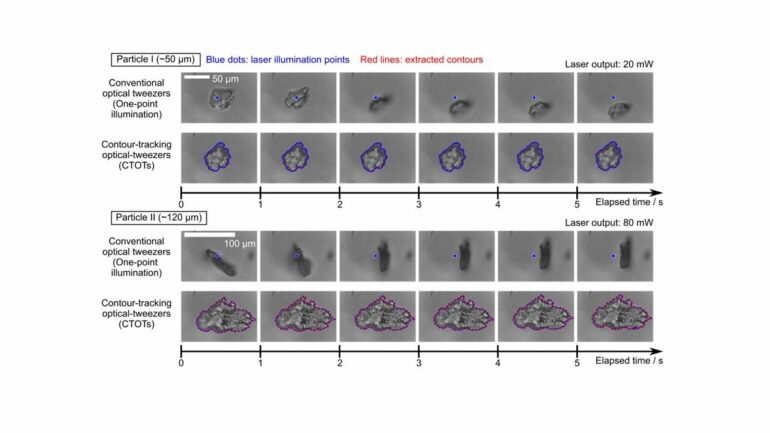Researchers have developed new optical tweezers that can stably trap particles that are large—about 0.1 mm—and irregularly shaped. While conventional optical tweezers use highly focused laser beams to trap micro- or nano-scale rod shaped or spherical particles, the advance could expand light-based trapping to a wider range of objects such as groups of cells, bacteria and microplastics.
“Our goal is to develop an environmental measurement system that can inspect individual microplastics in detail,” said research team leader Satoru Takahashi from The University of Tokyo in Japan.
“Since microplastics in the environment vary greatly in size and shape, we began by developing a method to control the position and orientation of particles, including those that are large and irregularly shaped.”
In the journal Optics Letters, the researchers describe what they call contour-tracking optical tweezers. These tweezers use imaging processing to extract the contour of the target particle from microscope camera images and then automatically shape the scanning light pattern that is used for trapping to match the extracted contour in real time.
“Our new optical tweezers could potentially be used with living organisms such as plankton and 3D cultured cells as well as environmental samples,” said the paper’s first author Ryohei Omine.
“This would enable observation and analysis with precise manipulation, which would contribute to a deeper understanding of their behaviors in various settings. For example, analyzing the behavior of microplastics could inform more effective measures to mitigate pollution, thereby improving human health and environmental conservation.”
Trapping that adapts
Conventional optical tweezers can typically only trap symmetrical shapes like spheres and rods because shapes that are asymmetrical or distorted cause the forces exerted by the light on the object to be unbalanced. This leads to uncontrollable rotation or displacement from the laser’s focal point.
The new optical tweezers overcome this limitation by scanning the laser focal point along the extracted contour of the target particle, balancing the optical forces around irregularly shaped particles. Additionally, the size of scanning light patterns can be adjusted automatically to fit the target size, allowing it to be used on particles larger than 0.1 mm.
“Although counter-propagating beams have been demonstrated for trapping large particles, these lack the stability and controllability needed for irregularly shaped particles,” said Takahashi.
“Our contour extraction scheme offers a viable alternative and can also be applied to holographic optical tweezers, which use spatial light modulators to shape the laser beam into 3D patterns, thus allowing simultaneous manipulation of multiple particles with high precision.”
Capturing widely varying particles
The researchers made the contour-tracking optical tweezers by integrating a real-time image processing unit with a 2D manipulated optical tweezer system based on galvanometer mirrors. They then used this setup to trap irregularly shaped polystyrene particles, from 0.05 to 0.12 mm in size, created by polishing a polystyrene spoon with a file.
The results showed that the new optical tweezers could provide stable trapping of large, irregular-shape particles that are difficult to trap using conventional optical tweezers. This was achieved without prior knowledge of particle morphology and without the need for dual-sided laser illumination, thus demonstrating the versatility and scalability of this approach.
Although the researchers have shown that stable trapping is possible, they are now working to control particles’ positions and orientations precisely to allow detailed sample observations with active manipulation. They plan to do this by enhancing the light pattern generation process by incorporating modulation of the contour shape based on the particles’ motion.
More information:
Ryohei Omine et al, Manipulation of large, irregular-shape particles using contour-tracking optical tweezers, Optics Letters (2024). DOI: 10.1364/OL.524424
Citation:
New optical tweezers can trap large and irregularly shaped particles (2024, May 14)



